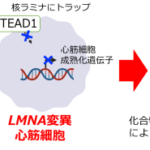2023-04-14 ペンシルベニア州立大学(PennState)
ペンシルベニア州立大学の研究チームは、老化やその他の代謝プロセスを制御する酵素が、どのように遺伝物質にアクセスして細胞内の遺伝子発現を調節しているのかを明らかにする新しい研究結果を発表しました。
ペンシルベニア州立大学の研究チームは、サーチュイン酵素がヌクレオソーム(DNAとヒストンと呼ばれるタンパク質が密に結合した複合体)に結合している画像を作成し、酵素がヌクレオソーム複合体を移動してDNAとヒストンタンパク質の両方にアクセスし、ヒトや他の動物でどのように機能しているかを明らかにしました。
本成果は、4月14日発行のScience Advances誌に掲載される予定です。
<関連情報>
- https://www.psu.edu/news/eberly-college-science/story/how-does-aging-associated-enzyme-access-our-genetic-material/
- https://www.science.org/doi/10.1126/sciadv.adf7586
ヒトサーチュイン 6-ヌクレオソーム複合体の低温電子顕微鏡構造 Cryo-EM structure of the human Sirtuin 6–nucleosome complex
Un Seng Chio,Othman Rechiche,Alysia R. Bryll,Jiang Zhu,Erik M. Leith,Jessica L. Feldman,Craig L. Peterson,Song Tan,Jean-Paul Armache
Science Advances Published:14 Apr 2023
DOI:https://doi.org/10.1126/sciadv.adf7586

Abstract
Sirtuin 6 (SIRT6) is a multifaceted protein deacetylase/deacylase and a major target for small-molecule modulators of longevity and cancer. In the context of chromatin, SIRT6 removes acetyl groups from histone H3 in nucleosomes, but the molecular basis for its nucleosomal substrate preference is unknown. Our cryo–electron microscopy structure of human SIRT6 in complex with the nucleosome shows that the catalytic domain of SIRT6 pries DNA from the nucleosomal entry-exit site and exposes the histone H3 N-terminal helix, while the SIRT6 zinc-binding domain binds to the histone acidic patch using an arginine anchor. In addition, SIRT6 forms an inhibitory interaction with the C-terminal tail of histone H2A. The structure provides insights into how SIRT6 can deacetylate both H3 K9 and H3 K56.


